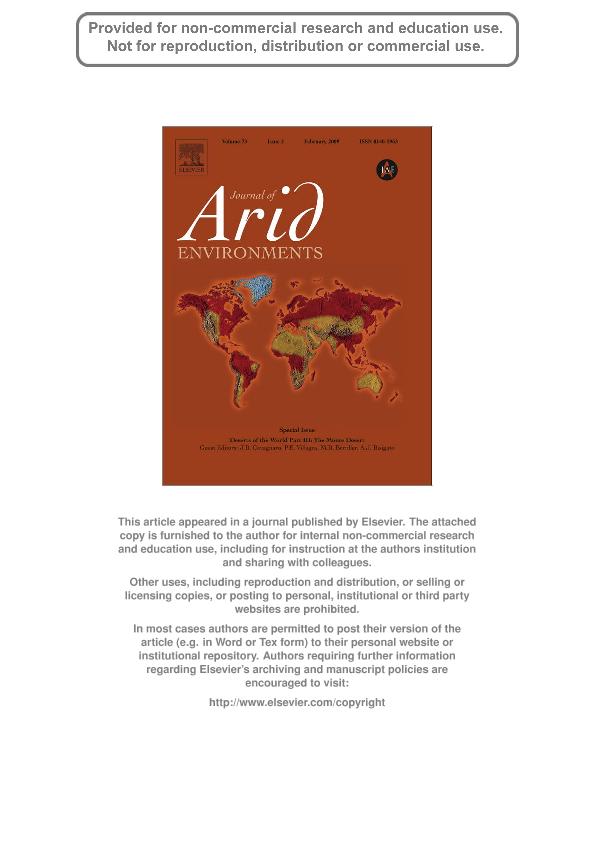Artículo
Range and livestock production in the Monte Desert, Argentina
Guevara, Juan Carlos ; Grunwaldt, Eduardo Guillermo
; Grunwaldt, Eduardo Guillermo ; Estevez, Oscar Roberto
; Estevez, Oscar Roberto ; Bisigato, Alejandro Jorge
; Bisigato, Alejandro Jorge ; Blanco, L. J.; Biurrun, Fernando; Ferrando, C. A.; Chirino, Claudia Cecilia; Morici, Ernesto Francisco Atilio; Fernández, B.; Allegretti, Liliana Inés; Passera, Carlos Bernardo
; Blanco, L. J.; Biurrun, Fernando; Ferrando, C. A.; Chirino, Claudia Cecilia; Morici, Ernesto Francisco Atilio; Fernández, B.; Allegretti, Liliana Inés; Passera, Carlos Bernardo
 ; Grunwaldt, Eduardo Guillermo
; Grunwaldt, Eduardo Guillermo ; Estevez, Oscar Roberto
; Estevez, Oscar Roberto ; Bisigato, Alejandro Jorge
; Bisigato, Alejandro Jorge ; Blanco, L. J.; Biurrun, Fernando; Ferrando, C. A.; Chirino, Claudia Cecilia; Morici, Ernesto Francisco Atilio; Fernández, B.; Allegretti, Liliana Inés; Passera, Carlos Bernardo
; Blanco, L. J.; Biurrun, Fernando; Ferrando, C. A.; Chirino, Claudia Cecilia; Morici, Ernesto Francisco Atilio; Fernández, B.; Allegretti, Liliana Inés; Passera, Carlos Bernardo
Fecha de publicación:
02/2009
Editorial:
Academic Press Ltd - Elsevier Science Ltd
Revista:
Journal of Arid Environments
ISSN:
0140-1963
Idioma:
Inglés
Tipo de recurso:
Artículo publicado
Clasificación temática:
Resumen
This article reviews and analyzes the available information on range and livestock production in the Monte Desert. Cow-calf operations, goats for meat, and sheep for wool are the dominant production systems under continuous grazing. Rest-rotational grazing systems improved the efficiency of the current cow-calf production. Forage resources are primarily composed of perennial grasses and woody species. Rain-use efficiency for the total vegetation ranged from 3.9 to 4.8 kg DM ha-1 year-1 mm-1. Carrying capacity showed a broad range: 18.7, 4.5-64.5, and 21.6-89.3 ha AU-1 in the north, central, and south portions of the Monte, respectively. Mean crude protein (CP) content of grasses varied from 8.4 to 10.3 (wet season) and 7.1-3.7% DM (dry season) in the central west and Patagonia, respectively. Grasses predominated in the cattle diet, while the sheep diet was highly diverse because they ate most of the available plant species, and there was no unanimity as to the fact that goats are strictly browsers. Livestock diseases have lower prevalence indices than those recorded in other areas of the country. The high variability in carrying capacity values could be attributed to differences in rangeland condition and to the different methods used for its estimation. The CP levels in forage could meet cattle requirements provided that a proper-stocking rate were used. The most promising species for land rehabilitation are Opuntia, Atriplex spp., Eragrostis curvula and Cenchrus ciliaris. Priorities for future research should include topics such as assessment of the carrying capacity for most of the areas and nutrient content of the components of livestock diet, the livestock intake values, the economic feasibility of the use of complementary feeds and the development of seeding technology for valuable forage resources as Trichloris crinita, among others.
Archivos asociados
Licencia
Identificadores
Colecciones
Articulos(CCT - MENDOZA)
Articulos de CTRO.CIENTIFICO TECNOL.CONICET - MENDOZA
Articulos de CTRO.CIENTIFICO TECNOL.CONICET - MENDOZA
Articulos(CCT-CENPAT)
Articulos de CTRO.CIENTIFICO TECNOL.CONICET - CENPAT
Articulos de CTRO.CIENTIFICO TECNOL.CONICET - CENPAT
Articulos(IADIZA)
Articulos de INST. ARG DE INVEST. DE LAS ZONAS ARIDAS
Articulos de INST. ARG DE INVEST. DE LAS ZONAS ARIDAS
Articulos(IANIGLA)
Articulos de INST. ARG. DE NIVOLOGIA, GLACIOLOGIA Y CS. AMBIENT
Articulos de INST. ARG. DE NIVOLOGIA, GLACIOLOGIA Y CS. AMBIENT
Citación
Guevara, Juan Carlos; Grunwaldt, Eduardo Guillermo; Estevez, Oscar Roberto; Bisigato, Alejandro Jorge; Blanco, L. J.; et al.; Range and livestock production in the Monte Desert, Argentina; Academic Press Ltd - Elsevier Science Ltd; Journal of Arid Environments; 73; 2; 2-2009; 228-237
Compartir
Altmétricas



